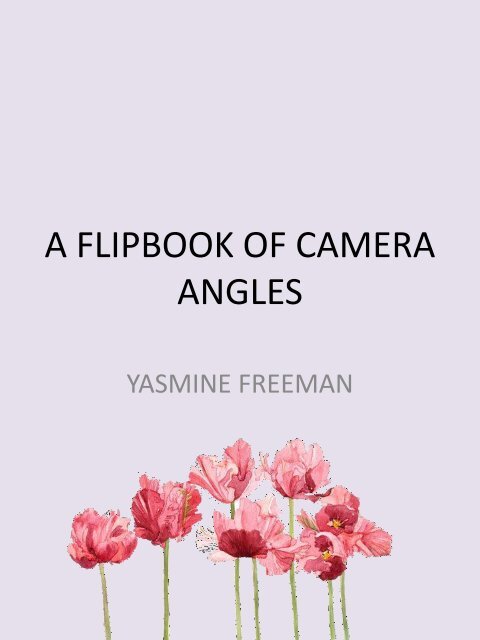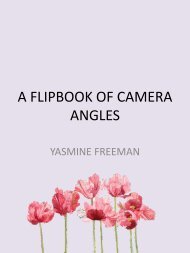A FLIPBOOK OF CAMERA ANGLES 2 pdf
You also want an ePaper? Increase the reach of your titles
YUMPU automatically turns print PDFs into web optimized ePapers that Google loves.
A <strong>FLIPBOOK</strong> <strong>OF</strong> <strong>CAMERA</strong><br />
<strong>ANGLES</strong><br />
YASMINE FREEMAN
CONTENTS PAGE<br />
• Time lapse……………………………………1<br />
• Close up……………………………………….2<br />
• Portrait…………………………………………3<br />
• Single frame…………………………………4<br />
• Extreme wide shot……………………….5<br />
• Other than subject……………………….6<br />
• Wide shot…………………………………….7<br />
• Noddy shot…………………………………..8<br />
• Over shoulder……………………………...9<br />
• Pointing shot………………………….…..10<br />
• Background………………………………..11<br />
• Cut-in………………………………………….12
TIME LAPSE
Close up<br />
A camera angle showing the subject close<br />
up and in more detail. A close-up or close<br />
up in filmmaking, television production,<br />
still photography and the comic strip<br />
medium is a type of shot, which tightly<br />
frames a person or an object. Close-ups<br />
are one of the standard shots used<br />
regularly with medium shots and long<br />
shots (cinematic techniques).
Portrait<br />
This angle shows us what a usually landscape photo<br />
would be seen as if it had been taken as portrait. Portrait<br />
photography or portraiture is photography of a person or<br />
group of people that captures the personality of a subject<br />
by using effective lighting, backdrops, and poses.<br />
A portrait picture might be artistic, or it might be clinical,<br />
as part of a medical study.
Single Frame<br />
Single frame, this shows the subject/ object and<br />
only the subject/ object. A point of view shot (also<br />
known as POV shot, First-person shot or a<br />
subjective camera) is a short film scene that shows<br />
what a character (the subject) is looking at<br />
(represented through the camera).
Extreme wide shot<br />
Extreme wide shot, this shows a wide angle of a landscape,<br />
showing a range of different things. In the extreme wide<br />
shot, the view is so far from the subject that s/he isn't even<br />
visible. The point of this shot is to show the subject's<br />
surroundings. The EWS is often used as an<br />
"establishing shot" - the first shot of a new scene, designed<br />
to show the audience where the action is taking place.
Cut away<br />
This angle is the subject but with the focus on<br />
another object rather than the subject, in this,<br />
it’s the pen. A shot of something other than<br />
the subject.
Wide shot<br />
This angle shows a wide shot but with less in it, unlike<br />
a panorama, it is cut off so you cant see past the<br />
corners. In photography, film making and video<br />
production, a long shot (sometimes referred to as a<br />
full shot or a wide shot) typically shows the entire<br />
object or human figure and is usually intended to<br />
place it in some relation to its surroundings. A<br />
long shot is often used to set the scene in a film.
Noddy shot<br />
A photo of someone showing a reaction in some<br />
way. Noddy headshots or noddies are a type of<br />
camera shot used in recorded news or current<br />
affairs interviews
Over shoulder<br />
A photo taken over the shoulder of another,<br />
taken from a different perspective. This is<br />
showing two subjects one seen as looking over<br />
the others shoulder is interpreting that persons<br />
perspective.
Pointing shot<br />
A photo taken of someone else pointing at the<br />
subject. This shows the person from another's<br />
point of view.
Background<br />
A photo of the subject but the view of what's<br />
happening in the background. Its<br />
the ground or parts, as of a scene, situated in the rear<br />
.
Cut in<br />
A cut-in shot is a close-up shot of something visible<br />
in the main scene. A cutaway shot is a shot away<br />
from the main scene.



